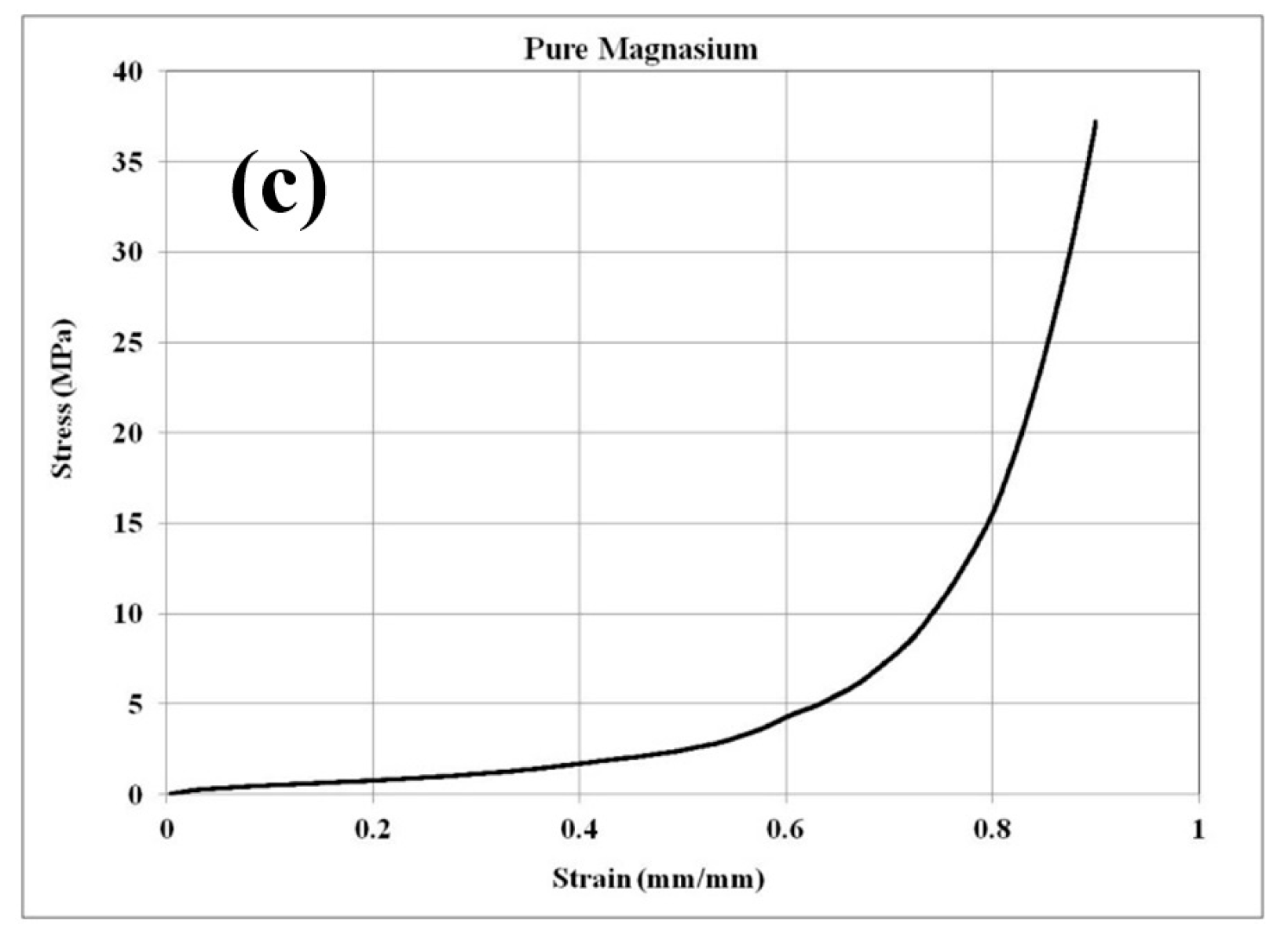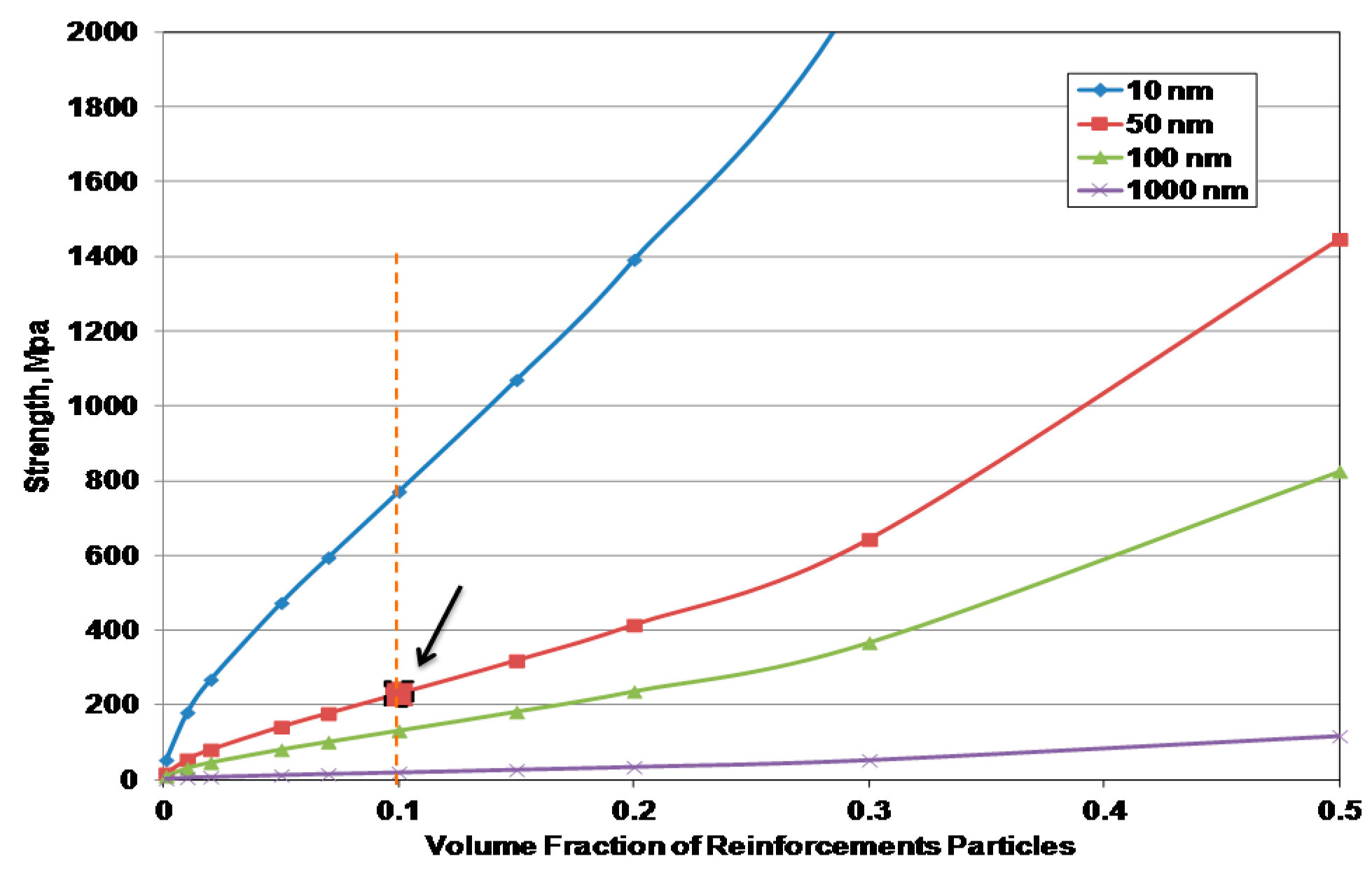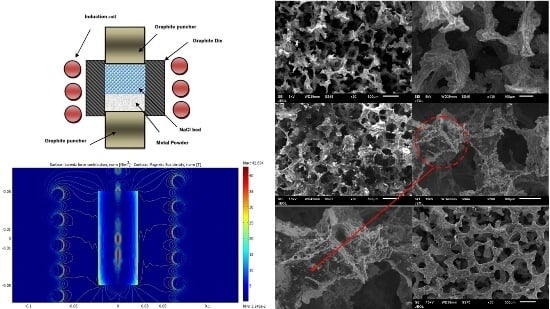Melt Processing and Characterization of Al-SiC Nanocomposite, Al, and Mg Foam Materials
Abstract
:1. Introduction
2. Materials and Methods
3. Results and Discussion
3.1. Microstructure
3.2. Compressive Properties
- M: the Taylor factor for the matrix,
- v and G: the poisson ratio of the matrix and shear modulus,
- R: the mean radius of the particle,
- λ: an effective inter—particle,
- b: the Burgers vector.
3.3. Energy Absorption
3.4. Fracture Surface
4. Conclusions
- The developed manufacturing technique in the presented study displayed a high applicability in producing different kinds of metallic foams.
- The metallic foams of Al-SiC, Al, and Mg were successfully manufactured by employing a metal infiltration under the stirring effect of the electromagnetic; thus, forces producing an isotropic foaming structure with micro-sized porosities in the range of 100–500 μm.
- Addition of 10 wt. % SiC resulted in a significant improvement in the compressive strength of the aluminum foam. The Al-SiC nanocomposite foam provided the highest compressive strength of 50 MPa prior to the densification stage compared to 5 MPa achieved by pure aluminum and 25 MPa achieved by pure magnesium.
- The produced Al-SiC nanocomposite foam displayed a high level of energy absorption of 48 MJ/m3 compared to 1 MJ/m3 and 6.4 MJ/m3 for Al and Mg foam materials, respectively.
- The outstanding strengthening effects of SiC nano particles additionally indicate the elevated levels of the wettability and incorporation that can be achieved under the stirring effect of electromagnetic forces.
Acknowledgments
Author Contributions
Conflicts of Interest
References
- Pinto, P.; Peixinho, N.; Silva, F.; Soares, D. Compressive properties and energy absorption of aluminum foams with modified cellular geometry. J. Mater. Process. Technol. 2014, 214, 571–577. [Google Scholar] [CrossRef]
- Nayyeri, M.J.; Mirbagheri, S.M.H.; Amirkhanlou, S. High strength tailor-made metallic foams (TMFs): Development and characterization. Mater. Lett. 2015, 154, 152–155. [Google Scholar] [CrossRef]
- Li, Y.; Li, Z.; Han, F. Air flow resistance and sound absorption behavior of open-celled aluminum foams with spherical cells. Procedia Mater. Sci. 2014, 4, 187–190. [Google Scholar] [CrossRef]
- Xu, Z.; Hao, H. Electromagnetic interference shielding effectiveness of aluminum foams with different porosity. J. Alloy. Compd. 2014, 617, 207–213. [Google Scholar] [CrossRef]
- Hamadouche, A.; Nebbali, R.; Benahmed, H.; Kouidri, A.; Bousri, A. Experimental investigation of convective heat transfer in an open-cell aluminum foams. Exp. Therm. Fluid Sci. 2016, 71, 86–94. [Google Scholar] [CrossRef]
- He, S.-Y.; Zhang, Y.; Dai, G.; Jiang, J.-Q. Preparation of density-graded aluminum foam. Mater. Sci. Eng. A 2014, 618, 496–499. [Google Scholar] [CrossRef]
- Salvo, L.; Martin, G.; Suard, M.; Marmottant, A.; Dendievel, R.; Blandin, J.-J. Processing and structures of solids foams. Compt. Rendus Phys. 2014, 15, 662–673. [Google Scholar] [CrossRef]
- Wanga, W.; Burgueno, R.; Hong, J.-W.; Lee, I. Nano-deposition on 3-D open-cell aluminum foam materials for improved energy absorption capacity. Mater. Sci. Eng. A 2013, 572, 75–82. [Google Scholar] [CrossRef]
- Zhou, Y.; Li, Y.; Yuan, J. The stability of aluminum foams at accumulation and condensation stages in gas injection foaming process. Colloids Surf. A Physicochem. Eng. Asp. 2015, 482, 468–476. [Google Scholar] [CrossRef]
- Morsi, K.; Daoush, W.M. Al-TiH2 composite ‘particles’ as foaming precursors for metallic foams. Scr. Mater. 2015, 105, 6–9. [Google Scholar] [CrossRef]
- Fischer, S.F.; Schüler, P.; Bührig-Polaczek, F. Influence of the casting and mould temperatures on the (micro)structure and compression behaviour of investment-cast open-pore aluminium foams. Acta Mater. 2013, 61, 5152–5161. [Google Scholar] [CrossRef]
- Orbulov, I.N. Metal matrix syntactic foams produced by pressure infiltration—The effect of infiltration parameters. Mater. Sci. Eng. A 2013, 583, 11–19. [Google Scholar] [CrossRef] [Green Version]
- Mizumoto, M.; Murano, T.; Kagawa, A. Microstructure Control of Particle Reinforced Metal Matrix Composites Fabricated by Low-Pressure Infiltration Process. Mater. Trans. 2002, 43, 2629–2634. [Google Scholar] [CrossRef]
- Bekoz, N.; Oktay, E. The role of pore wall microstructure and micropores on the mechanical properties of Cu-Ni-Mo based steel foams. Mater. Sci. Eng. A 2014, 612A, 387–397. [Google Scholar] [CrossRef]
- Peroni, M.; Solomos, G.; Pizzinato, V. Impact behaviour testing of aluminium foam. Int. J. Impact Eng. 2013, 53, 74–83. [Google Scholar] [CrossRef]
- Liu, P.S. Tensile fracture behavior of foamed metallic materials. Mater. Sci. Eng. A 2004, 384, 352–354. [Google Scholar]
- Jiang, B.; Li, Z.; Lu, F. Failure mechanism of sandwich beams subjected to three-point bending. Compos. Struct. 2015, 133, 739–745. [Google Scholar]
- Vendra, L.; Neville, B.; Rabiei, A. Fatigue in aluminum-steel and steel-steel composite foams. Mater. Sci. Eng. A 2009, 517A, 146–153. [Google Scholar] [CrossRef]
- Rajak, D.K.; Kumaraswamidhas, L.A.; Das, S.; Kumaran, S.A. Characterization and analysis of compression load behaviour of aluminium alloy foam under the diverse strain rate. J. Alloy. Compd. 2016, 656, 218–225. [Google Scholar] [CrossRef]
- Nanostructured & Amorphous Materials Inc. Compounds, Silicon Carbide. Available online: http://www.nanoamor.com/inc/pdetail?v=1&pid=621 (accessed on 7 May 2016).
- Báez-Pimientoa, S.; Hernández-Rojasb, M.E.; Palomar-Pardavé, M.E. Processing and characterization of open-cell aluminum foams obtained through infiltration processes. Procedia Mater. Sci. 2015, 9, 54–61. [Google Scholar] [CrossRef]
- Nogi, K. The role of wettability in metal-ceramic joining. Scr. Mater. 2010, 62, 945–948. [Google Scholar] [CrossRef]
- Zhou, Q.; Zeng, L.; DeCicco, M.; Li, X.; Zhou, S. A comparative study on clustering indices for distribution uniformity of nanoparticles in metal matrix nanocomposites. CIRP J. Manuf. Sci. Technol. 2012, 5, 348–356. [Google Scholar] [CrossRef]
- Nayebi, B.; Bahmani, A.; Asl, M.S.; Rasooli, A.; Kakroudi, M.G.; Shokouhimehr, M. Characteristics of dynamically formed oxide films in aluminum calcium foamable alloys. J. Alloy. Compd. 2016, 655, 433–441. [Google Scholar] [CrossRef]
- Nabawy, A.M.; Zhang, Z.; Chen, X.-G. Synthesis of Al-Tib2 Nanocomposite Using High Frequency Induction Melting. In Proceedings of Materials Science & Technology 2013, Montreal, QC, Canada, 27–31 October 2013; pp. 1284–1293.
- Hernández, F.C.R.; Sokolowski, J.H. Comparison among Chemical and Electromagnetic Stirring and Vibration Melt Treatments for Al-Si Hypereutectic Alloys. J. Alloy. Compd. 2006, 426, 205–212. [Google Scholar] [CrossRef]
- Du, Y.; Lu, Y.; Wang, T.; Li, T.; Zhang, G. Effect of Electromagnetic Stirring on Microstructure and Properties of Al0.5CoCrCuFeNi Alloy. Procedia Eng. 2012, 27, 1129–1134. [Google Scholar] [CrossRef]
- Hussain, Z.; Suffin, N.S.A. Microstructure and Mechanical Behaviour of Aluminium Foam Produced by Sintering Dissolution Process Using NaCl Space Holder. J. Eng. Sci. 2011, 7, 37–49. [Google Scholar]
- Zhang, Z.; Chen, D.L. Contribution of Orowan Strengthening Effect in Particulate-Reinforced Metal Matrix Nanocomposites. Mater. Sci. Eng. A 2008, 483–484, 148–152. [Google Scholar] [CrossRef]
- Li, Y.; Zhao, Y.H.; Ortalan, V.; Liu, W.; Zhang, Z.H.; Vogt, R.G.; Browning, N.D.; Lavernia, E.J.; Schoenung, J.M. Investigation of Aluminum-Based Nanocomposites with Ultra-High Strength. Mater. Sci. Eng. A 2009, 527, 305–316. [Google Scholar] [CrossRef]









© 2016 by the authors; licensee MDPI, Basel, Switzerland. This article is an open access article distributed under the terms and conditions of the Creative Commons Attribution (CC-BY) license (http://creativecommons.org/licenses/by/4.0/).
Share and Cite
Nabawy, A.M.; Khalil, K.A.; Al-Ahmari, A.M.; Sherif, E.-S.M. Melt Processing and Characterization of Al-SiC Nanocomposite, Al, and Mg Foam Materials. Metals 2016, 6, 110. https://doi.org/10.3390/met6050110
Nabawy AM, Khalil KA, Al-Ahmari AM, Sherif E-SM. Melt Processing and Characterization of Al-SiC Nanocomposite, Al, and Mg Foam Materials. Metals. 2016; 6(5):110. https://doi.org/10.3390/met6050110
Chicago/Turabian StyleNabawy, Ahmed M., Khalil Abdelrazek Khalil, Abdulrahman M. Al-Ahmari, and El-Sayed M. Sherif. 2016. "Melt Processing and Characterization of Al-SiC Nanocomposite, Al, and Mg Foam Materials" Metals 6, no. 5: 110. https://doi.org/10.3390/met6050110








